How to Swim with Healthy Posture: Breaststroke
Vacation time is in full swing in the northern hemisphere. For many of us, being beachside or poolside gets us yearning for a dip, a splash, and a swim. And I’m guessing that many of us have been mesmerized and inspired by watching the Olympic pool athletes in action.

Swimming can be fun for all ages and abilities—and healthy posture keeps it back pain free. Image from Unsplash
In this blog post we’ll discuss breaststroke, which happens to be my favorite way of swimming, and how healthy posture enables you to swim breaststroke better, and avoid the neck and back aches that some people experience after.
Swimming starts with the inner corset
Have you ever wondered why some swimmers manage to move so well through the water? Here are some things they are likely doing:
- They are activating their inner corset strongly. This enables the trunk and spine to maintain its alignment in an aquadynamic position, reducing drag.
- Their limb movements originate from the large trunk muscles of the back, chest, psoas, and gluteal muscles, which produce the most power.
- These two things enable an efficient, coordinated, smooth technique that avoids “flailing” in various directions and dissipating energy.
There are many preferred variations with arm and leg angles, hand and finger positions, cadence, and so on. But these are details compared with the all-important strong inner corset. Once your torso has lost its structural integrity, any movement you generate will work partially against you, rather than contribute to propulsion.
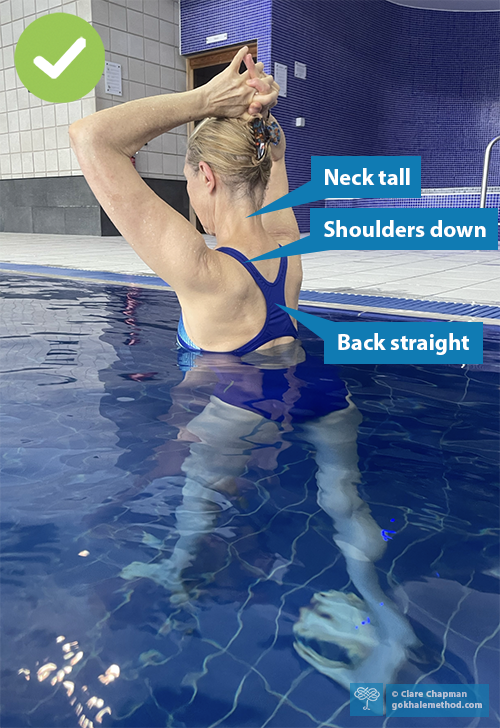
We need our inner corset in many activities to prevent distortions of the spine. Maintaining a straight course walking in the pool takes a strongly activated inner corset and is excellent prep for swimming.
The clue’s in the name
The name “breaststroke” is a good descriptor for the chest-opening benefits of this stroke. Done well, breaststroke can be a great antidote to many aspects of modern life that encourage us into stooped posture, rounding our shoulders, collapsing our chest, and breathing into our belly. As the hands and arms pull back, most of the muscle power behind that action comes from the upper back and rhomboids contracting to draw the shoulders back. We simultaneously open the ribcage and chest to fill the lungs.
How to breathe in but not sway your back
Breaststroke has an advantage over crawl in that breathing in is relatively easy while your head is well above the waterline. If, however, the lifting of the upper body happens in the upper lumbar spine rather than at L5-S1, the result is likely to be an achy neck and/or low back.
Professional or elite breaststroke swimmers have the strength and thrust to heave a large part of their upper body up out of the water, bending back exclusively at L5-S1; the upper lumbar spine and neck then have minimal need to extend back, if at all.
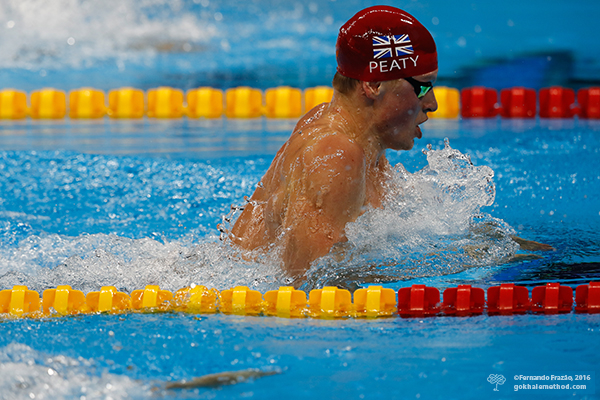
Olympic Gold Medalist Adam Peaty maintains a largely straight spine throughout most of his stroke. Image from Wikimedia
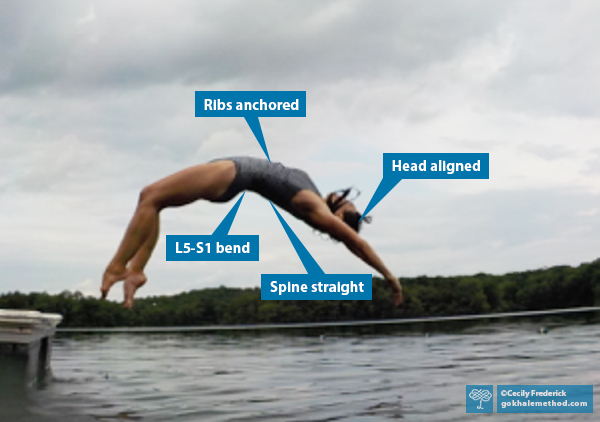
Cecily Frederick, a teacher of the Gokhale Method for many years, does a back dive with a healthy L5-S1 backbend—her upper lumbar area through to her head remains aligned straight.
Whatever your level of swimming, it is important when swimming breaststroke to counter any habit of lifting and swaying from the upper lumbar spine. The solution to this habit is to learn to engage the rib anchor muscles very strongly; with your rib anchor in place, you can learn to cultivate a healthy J-shaped spine rather than an S-shaped spine. You can learn more about spine shape here.
The posture benefits of the exhale phase
During the exhale phase the body settles horizontally into the water. This brings the great advantage of being able to rest, recover, and prepare the limbs for the next stroke. Part of this will include gliding through the water, which is conducive to recruiting the inner corset to steady and slenderize you. It offers a solid platform from which to launch the next stroke.
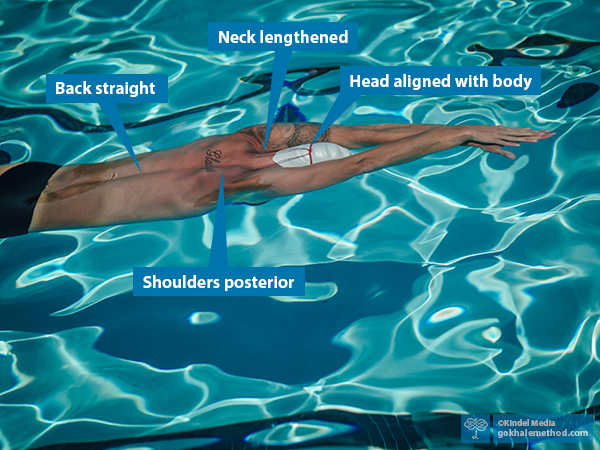
Practice floating or gliding through the water in a face-down, horizontal position. Then apply this to your stroke. Image from Pexels
If you don’t have the confidence to swim with your head in the water, consider gradually building familiarity with this skill with a friend or sympathetic swimming coach. Most people find it well worth mastering and, approached in the right way, much more enjoyable and comfortable. Wear goggles so that you can still see. Snorkels and full-face snorkels can be a useful measure for getting used to being face down in the water and experiencing the advantages of swimming in a horizontal position.
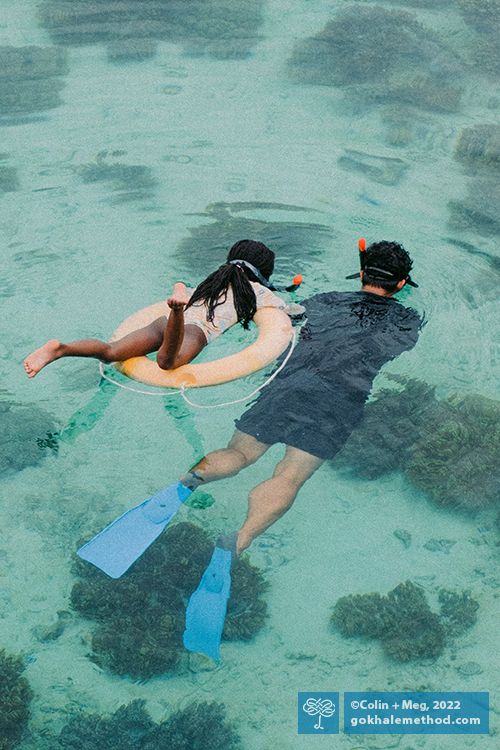
Snorkeling is a great way to get used to swimming in a face-down position with a long, more relaxed neck. Image from Unsplash
Hips and kicks
If your hips are very stiff, then you will benefit from breaststroke’s built-in opportunity to gradually increase your range of motion and muscular strength without loading the hip joint.
While it’s impressive to watch someone kicking wide with strong, flexible hips, it is not necessary, or even optimal, to go very wide with the legs. Watching a bird’s eye view of modern Olympic breaststrokers, you may be surprised by the narrowness of their kick. A narrower kick turns out to be more explosive and minimizes drag. Adam Peaty, the fastest breaststroker on the planet, estimates that up to 70% of his speed is generated by this narrow kick.
A narrow kick also makes breaststroke more accessible, especially for people with a limited range of motion in one or both hips. To narrow your kick, hold a pull buoy or two between the thighs as you swim. This leg arrangement also helps you to pattern healthy external rotation in your hips, legs, and feet, so you have a carry-over benefit for your land-based posture too!
A narrowed breaststroke kick has the advantages of speed, power, and developing external rotation in the legs. These young swimmers are training with a pull buoy.
If you have a pelvic rotation and/or SI joint instability, you may be prone to difficulties when attempting a wider kick; you are more likely to kick asymmetrically (called a screw kick), which is inefficient, and possibly risks injury. A narrow kick reduces these complications.
Legs externally rotated, a J-shaped spine, shoulders posterior, and an anchored rib cage, are not just tips for swimmers. These healthy posture principles are taught in our in-person Foundations course, one-day Pop-up course, our online Elements course, and our Gokhale Exercise program. Our students often report how much their swimming improves simply by applying these techniques.
Best next action steps for newcomers
If you would like insight on your posture, in and out of the pool, consider scheduling an Initial Consultation, online, or in person.
You can sign up below to join one of our upcoming FREE Online Workshops. . .

Comments
Add New Comment
Login to add commment
Login